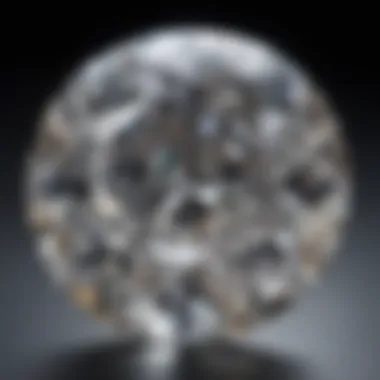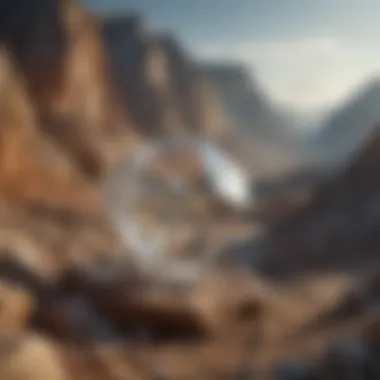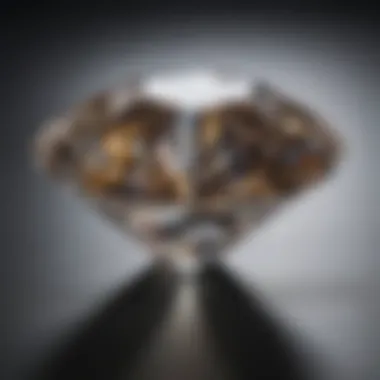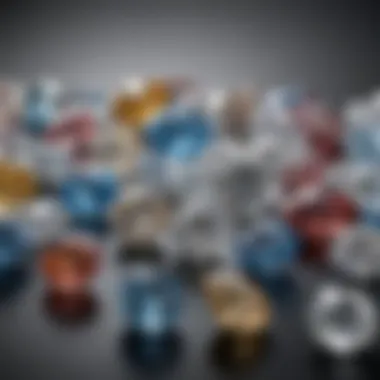Exploring the Essence of Real Diamond Gemstones


Intro
Rock and Fossil Identification
Types of Real Diamonds
Real diamonds can be categorized primarily into natural and synthetic forms. Natural diamonds form over billions of years under intense heat and pressure, while synthetic diamonds are man-made, often created within a few months using technological processes. Understanding the differences between these types is crucial for collectors.
Characteristics to Look For
When identifying real diamonds, there are several key characteristics to consider:
- Color: The color range in diamonds is vast, with most being nearly colorless, though hints of yellow or brown can occur. Specialty colors like blue, pink, and green are rarer and can significantly increase value.
- Clarity: This refers to the presence of inclusions, or internal flaws, in the diamond. Higher clarity results in more value.
- Cut: The cut affects a diamond's brilliance and shape; popular cuts include round, princess, and cushion.
- Carat weight: Larger diamonds are rarer and thus more valuable.
Tools for Identification
To accurately identify real diamonds, collectors can utilize a few essential tools:
- Jeweler's loupe: A magnifying glass used to inspect stones closely.
- Diamond tester: A device that measures the thermal conductivity of a stone to confirm its authenticity.
- Cameras with macro capabilities: Photographs can aid in detailed examinations and comparisons.
Collecting Tips and Techniques
Best Practices for Collecting
In the realm of diamond collecting, best practices ensure the acquisition of quality gems. Start by researching reputable dealers, studying diamond quality, and understanding market trends. It’s essential to develop a keen eye for details and packaging.
Locating Prime Collecting Sites
Opportunities to acquire diamonds arise at various venues:
- Gem shows: Events where multiple vendors showcase gemstones, providing keen collectors a unique shopping experience.
- Online auction platforms: E-commerce sites dedicated to gemstones often feature dealers and collectors selling legitimate diamonds.
- Estate sales: These can provide unexpected gems in intimate settings.
How to Safely Extract Specimens
Verify authenticity when buying diamonds. Always ask for certification from organizations like the Gemological Institute of America (GIA). Ensure that you have transparent policies regarding returns and dissatisfaction. Collecting should symbolize joyful acquisition, not regret.
Preservation and Display
Techniques for Preserving Diamonds
Diamonds require minimal special care, but it’s beneficial to:
- Clean them with mild soap and lukewarm water when necessary.
- Store your diamonds away from other jewelry to avoid scratches and damage.
Proper Storage Methods
Maintain your precious items properly:
- Use a soft cloth pouch: Helps to reduce scratching.
- Jewelry box with compartments: Separates different pieces to maintain integrity.
Creative Display Ideas
Displaying diamonds adds a personal touch to their beauty:
- Layer items within display cases- provides viewing areas while reducing damage risks.
- Use LED lights to enhance sparkle and artistry on display pieces.
Understanding the beauty and complexity of real diamond gemstones might seem daunting. Yet, knowledge brings power to collectors, assuring informed buying and preserving practices.
Geological Insights
Geological Formations and Processes
Diamonds form in a diverse set of geological conditions, mainly 150 kilometers beneath the Earth's surface where volcanic activity can bring them to the surface through kimberlite pipes. This formation reveals a beautiful connection between geological processes and mineralogy.
Historical Significance of Diamonds


Diamonds have captivated human interest for centuries, symbolizing wealth and power. Diamonds were popularized within European royal families and cultures, leading to their association with love and commitment in formats such as engagement rings.
Notable Discoveries in the Field
Several discoveries highlight geological significance in the diamond journey, like the Cullinan diamond, mined in South Africa in 1905. This specific gem became part of British crown jewels, signifying diamonds enduring legacy in history.
Through this exploration of real diamonds, their relevance in the natural world intertwined with human culture becomes clearer. Collectors of real diamond gemstones benefit from understanding nuanced details, assisting in the appreciation of these enduring beauties.
Intro to Diamond Gemstones
Diamonds hold a unique position in both the worlds of gemology and aesthetics. In this article, we focus on real diamond gemstones, uncovering everything from their formation to ethical considerations in sourcing. Understanding diamonds is essential not just for collectors but also for anyone invested in the charm and value they represent.
Importance of Diamonds
Diamonds are symbols of wealth, engagement, and rare beauty. They have application across various fields, from industry to personal adornment. In gemology, the exploration of diamonds goes beyond appearances. Knowledge of diamonds helps collectors understand the market, value, and cultural significance.
Definition of Diamond
A diamond is a crystalline form of carbon, structured in an arrangement that gives it a distinctive hardness and brilliance. To be classified as a real diamond, it must meet specific geological and aesthetic criteria. The qualities that create these spectacular minerals also contribute to their considerable economic value.
Properties that Define Diamonds:
- Hardness: Diamonds are the hardest known natural material, which makes them highly sought after for both industrial applications and as gemstones.
- Transparency: High clarity and the ability to refract light contribute to a diamond's captivating gleam.
The allure of diamonds is far from superficial; they embody an extraordinary blend of nature's artistry and geological processes, thus creating lasting appeal in many forms.
Significance in Gemology
In the field of gemology, diamonds are crucial objects of study due to their unique properties and varying qualities. Their exquisite beauty is bolstered by complex grading systems that evaluate the four Cs: cut, clarity, color, and carat weight. Each of these factors plays a significant role in determining a diamond's beauty and price.
"The assessment of diamonds is not merely about aesthetic appeal; it is an intricate combination of science and art."
Why Understanding Gems Matters:
- Market Value: Knowledge of the grading system assists collectors and buyers in navigating the finances of diamond investments.
- Cultural Importance: The symbolism and significance of diamonds across cultures cannot be understated. They carry historical meanings that enrich their value, serving as tokens of commitment or symbols of prestige.
Recognizing diamond gemology’s depth cultivates a better understanding and appreciation of these coveted natural wonders.
Formation of Diamonds
The formation of diamonds is a fundamental aspect when discussing these iconic gemstones. Understanding how diamonds come to exist enhances not just their allure but also their value in the collectors' market. Diamonds formed over millions of years deep within the Earth's mantle. The geological conditions and unique elements that contribute to their creation play a significant role in defining their characteristics. As collectors, knowing where and how a diamond is formed can influence how one values and gathers these stones.
Geological Processes
Diamonds are produced under extreme heat and pressure, which are critical elements of their formation. This usually occurs at a depth of approximately 90 to 120 miles beneath the Earth's surface. Here, carbon sources are trapped, undergoing metamorphic processes. The uninterrupted conditions over geologic timescales cause diamonds to crystallize. These processes include:
- High pressure: This exceeds 725,000 pounds per square inch.
- High temperature: Typically ranges between 1,300 to 2,500 degrees Fahrenheit.
These processes lead to the natural growth of diamonds, making every gemstone uniquely shaped and externally different, composed primarily of carbon atoms.
Diamonds are born from a natural symphony of geological processes across millennia.
The journey to the Earth's surface is equally fascinating. Volcanoes can present diamonds through eruptions, while the rough stones continue to change over time in various locations. Knowing these geological elements solidifies a collector's appreciation.
Natural vs.
Synthetic Diamonds
In recent years, understanding the distinction between natural and synthetic diamonds has gained importance, especially within the collectors' community.
Natural diamonds are those formed naturally it great depths and times, as discussed earlier. Conversely, synthetic diamonds are artificially cultivated in laboratories. Today's technology allows for rapid creation, making this category that sometimes mimics natural stones, both visually and structurally. The critical differences include:
- Origin: Natural diamonds come from the Earth, while synthetic diamonds are produced through methods such as High-Pressure High-Temperature (HPHT) and Chemical Vapor Deposition (CVD).
- Cost: Typically, synthetic diamonds can be significantly cheaper than natural ones.
Collectors often face decisions regarding whether to invest in either option, influenced by personal priorities such as ethics, supply, and quality. Educating oneself on these differences is a pressing need for those serious about diamond collecting. Knowing the provenance of a diamond can also speak to its value, especially in terms of rarity.
Characteristics of Diamonds


Diamonds are not just valued for their aesthetics; their characteristics offer insights about their quality and worth. Understanding the characteristics of diamonds is crucial for anyone interested in gemstones, particularly collectors. This knowledge defines the grading, valuation, and desirability of diamonds. In this section, we will explore important factors that contribute to the overall value and significance of real diamond gemstones in the market.
The Four Cs
Cut
The cut of a diamond is one of its most crucial attributes. It affects how light dissociates in the gemstone, thus contributing to its brilliance. Beyond visuals, the precision of the cut can dictate the price. A precise cut enhances the sparkle, making the stone much easier to sell or trade.
A well-cut diamond is often sought after. Cut is essential as a poorly cut diamond can appear dull, regardless of its clarity or color. Collectors appreciate well-cut diamonds for their unique capacity of maximizing light return. Hence, investing in a diamond with a superior cut can provide great satisfaction and prestige depending on the quality.
Clarity
Clarity refers to the absence of internal or external flaws, known as inclusions and blemishes. This is an important factor for the value of diamonds. The fewer inclusions a diamond has, the more valuable it is. Our eyes may not always detect these flaws without professional help, but clear stones resonate with style and value.
A high-clarity stone is generally considered a benefit. Collectors often prefer these diamonds for their brilliance and overall aesthetic appeal. However, a balance exists where some buyers actually pursue diamonds with small inclusions for uniqueness. Clarity is a significant characteristic, allowing individuals to appreciate both quality and imperfections in a gem.
Color
Color is a distinctive aspect when evaluating diamonds. Most most diamonds appear colorless, but grading granulates along a scale of colors. Those close to colorless are seen as top in quality. Minor variations exist, from the subtle hints of yellow or brown to unconscious shades of pink, blue, or green. Such colors can drastically influence the price.
It’s also key in distinguishing the uniqueness of diamond choices. Many opt for slightly tinted diamonds as they vary from standard appearances. This uniqueness can enhance its desirability for collectors seeking extraordinary pieces. Thus, paying attention to color is essential in any collector’s assessment.
Carat Weight
Carat Weight serves as a primary indicator of size and can heavily influence pricing. Glossary wise, the weight is equal to 200 milligrams. Larger diamonds are often rarer than smaller ones, thereby attracting more attention. This can encourage collectors to invest in carat weightstrings to achieve significant discovery.
Consequently, larger diamonds naturally indicate higher values. However, count is not the soul criteria; it's always interlinked with cut, carbon, and clarity. Buyers might want to focus on standalone notable properties rather than just weight for weight’s sake. A one-carat stone may often remain quite desirable if it possesses a good cut and clear sighting.
Other Notable Properties
Hardness
A diamond's hardness contributes heavily to its desirability. In fact, diamonds stand at the highest position on the Mohs scale of mineralogy, assigned a score of ten. This superior hardness ensures that diamonds do not easily scratch, maintaining them as highly durable choices. Further, their tenacity generates greater appeal and robustness.
However, attaining that level of hardness permits implications; cut collectors love the designs that markers offer in diamond surrounded creations. For pure collector artisans, means can be spurious but diamonds' operational stance resonates indefinitely well across varied horizons.
Refractive Index
The refractive index defines how diamonds bend light. The unique feature here hinges on the high refraction which intensifies sparkle. Achieving vibrant dispersion makes diamonds examples of ultimate light refraction. Enhanced appeal acts to drive demand in many decisively involved collectors.
Understanding this element supplements a superb foundation for analytical collection choices in vast arrays. Appreciation nurtured flows smoothle when scientific dictates are exemplified for modifications into investments, thus showcasing their allure naturally not only in presence but also in balance terms.
In examining these characteristics, it becomes explicitly clear that a diamond's total significance extends beyond simple appearance; it encompasses an amalgamation of quality, durability, and elegance insufflated seamlessly in the eyes of discerning collectors. An impression Kalvin users could take by relying on insights offers a mission towards the essence diamonds can delegate ultimately.
Ethical Considerations
The significance of ethical considerations in the diamond industry cannot be overstated. As problematic as it may seem, the complexities surrounding diamond sourcing and sales challenge both ethical integrity and consumer awareness. Diamonds symbolize beauty and wealth, but ethical dilemmas can overshadow their allure. Addressing these concerns educates both consumers and collectors, reinforcing the values of responsibility in gemstone trading.
Conflict Diamonds
Conflict diamonds, also known as blood diamonds, are stones mined in wartime conditions and sold to finance armed conflict against governments. The term particularly refers to situations in countries like Sierra Leone, Angola, and the Democratic Republic of the Congo. The illicit trade of these diamonds has gained global attention primarily due to human rights abuses and ethical violations that it perpetuates.
It is crucial for collectors to recognize and avoid diamonds that have a problematic origin. By ensuring the legitimacy of the sources from which they purchase diamonds, collectors can contribute to alleviating circumstances that exploit vulnerable populations. The Kimberly Process Certification Scheme was established in 2003 to track the origins of diamonds and certify them as conflict-free. However, inconsistencies and lapses in this process have raised continued concerns over its effectiveness.
"With increasing awareness around the ethical implications of labor practices in mining, a thoughtful consideration of diamond sourcing practices feels more relevant than ever."
A conversation about diamonds must also include dialogue about conflict and human rights. Such engagement not only enhances individual awareness but also propels the entire industry towards more ethical standards. Collecting real diamonds becomes a meaningful aspect, juxtaposed with their economic value, as ethical transparency gains importance.
Sourcing and Certification
Sourcing and certification are vital pillars for ensuring ethical practices within the diamond market. Understanding these processes empowers consumers and collectors with information necessary for responsible purchasing decisions.
Diamonds can be sourced from various geographical regions and political climates. Collectors face the challenge of verifying the provenance as reliable certification helps authenticate a diamond's claim of being conflict-free. Many believe that investing time into comprehending sourcing methods improves both the quality of purchasing decisions and the legitimacy of the marketplace.
Certifications help provide clarity regarding these gemstones and serve as a critical benchmark for quality and ethical considerations. Reputable organizations typically offer recognized grading reports; for instance, the Gemological Institute of America (GIA) or the International Gemological Institute (IGI). The reports produced by such authorities confirm crucial aspects, like the diamond's quality while including provenance and ethical sourcing information. Failure to adequately certify can mislead potential buyers into unknowingly participating in complicated ethical issues.
Ultimately, knowledge around ethical sourcing reinforces the bond between collectors and their prized diamonds. It encourages a conscientious collection process, one that honors both the gemstone's beauty and the moral implications tied to it. Efforts to only collect ethically sourced gems afford collectors the opportunity to contribute toward more responsible practices in the gem industry.


Value of Real Diamonds
The significance of real diamonds in today’s world encompasses various facets, particularly in the realms of collections, investments, and aesthetic appeal. Diamonds are not just precious stones but also cultural symbols that come with a series of historical narratives and personal connections. Understanding their value can greatly affect the decisions made by collectors and enthusiasts alike. This section delves into the fluid market trends and specific factors influencing diamond pricing.
Market Trends
Market trends provide a window into the dynamics shaping diamond values over time. Recent years have seen considerable fluctuations influenced by a range of factors, including global economic conditions, changing consumer preferences, and ethical considerations surrounding sourcing.
A notable trend is the increasing demand for ethically-sourced diamonds. Collectors and consumers are becoming more aware of the implications behind diamond mining and production. This awareness often shifts focus toward conflict-free options. Consequently, diamonds with a verifiable ethical origin tend to receive premium pricing, reflecting a growing alignment of values among collectors and investors with their purchasing choices.
Furthermore, technological advancements, notably in online sales platforms, have widened the collector base, making diamonds more accessible to a larger audience. Digital marketplaces can significantly define how diamonds are bought and sold, creating an ever-evolving landscape.
Some key points highlighting market trends include:
- Shift toward ethically-sourced diamonds
- Influence of technology and online sales platforms
- Response of the market to global economic fluctuations
Pricing Factors
Understanding the specifics of diamond pricing requires contemplating various integral factors. The Four Cs — Cut, Clarity, Color, and Carat Weight — remain core criteria that influence the valuation of diamonds, creating a foundational pricing structure. Each of these aspects carries its characteristics which signify differences in desirability and hence the monetary worth.
- Cut determines how well a diamond interacts with light, affecting brilliance and sparkle.
- Clarity defines the presence of internal or external imperfections, impacting visual appeal.
- Color can influence value: diamonds that are colorless or near-colorless are often more prized.
- Carat Weight correlates directly to size; larger diamonds typically command higher prices.
Additionally, market demand plays a crucial role. Variations in consumer behavior, seasonal demand, and shifts in fashion trends directly influence prices.
Other pricing considerations may encompass:
- Historical significance or rarity of specific diamond types
- Certification from respected gemological laboratories
- Current economic conditions influencing both purchasing power and collector investment
Collecting Diamond Gemstones
Collecting diamond gemstones holds significant importance in this article, serving as a nuanced exploration into both the culture around and the intrinsic value of diamonds. Collectors often seek to broaden their understanding of diamonds beyond aesthetics; they delve into the processes that govern value, rarity, and philosophical reflection on gemstone significance. Moreover, responsible collecting involves ethical sourcing and knowledge of geological origins which can enhance a collector's investment and appreciation of their pieces.
Through collecting, enthusiasts can acquire unique pieces that not only hold economic value but also serve as historical artifacts connecting us to Earth’s natural processes over millennia. Engaging in this realm encourages individuals to explore different styles, cuts, and origins. With an increasing market trend favoring ethically sourced gems, understanding these issues forms the backbone of a successful collection, ensuring longevity not just of the gems but of the hobby itself.
Guidelines for Collectors
When embarking on addiction to collecting diamond gemstones, certain guidelines can help cultivate a well-rounded collection. While it is tempting to procure a stunning gem impulsively, strategy and forethought can yield much greater rewards. Here are few practical strategies:
- Research: Understand the story behind different diamonds. This combines geological knowledge with treasures’ histories, significantly increasing their charm.
- Networking: Engage with communities focused on gemstones, such as forums on Reddit or specialized groups on Facebook. Opportunities to gain insider knowledge about upcoming sales or facets of collection can be invaluable.
- Authentication: It is crucial to buy from accredited sellers or to get a stone authenticated. A good place to find sourcing validated diamonds are venues like jeweler workshops or certified auctions.
- Documentation: Keep thorough records of your gemstones, including purchase details and certifications. Paperwork adds additional value and can influence resale potential.
- Variety: Aim for a balanced selection, combining different types, cuts and colors. This can make your collection visually appealing and helps with appraisal diversity.
Ultimately, the aim should be to create not just a collection but a story—one that promotes individual identity while navigating the intricacies of diamond collecting.
Displaying and Preserving Diamonds
Passion for diamond gemstones should extend into their display and preservation. Quite aside from value, there are aesthetic merits to how one positions these creations in their environment. Presentation groups the diamonds within a context that can own a cherished space in your life. Here are efficient methods to display and maintain your collection:
- Proper Storage: Diamonds must be stored safely. Using a velvet-lined jewelry box or heat-resistant safe can provide the necessary protection against scratches. Remember that although diamonds are tough, they can chip or fracture when pressured the wrong way.
- Regular Cleaning: Gentle cleaning of your diamonds with a mild detergent and soft cloth preserves sparkle and brilliance. This allows any imperfections to be easily observed, ensuring the gem retains quality.
- Showcase*: Use display cases or shadow boxes that maintain humidity control while displaying. Ensure high-quality lighting to achieve the artistic look
- Limit Exposure: Minimize wear to everyday activities with the gemstones unless it contemplates with great care. Prolonged contact with chemicals may underestimate conditions of precious stones.
- Visit Experts: Consulting jewelry or diamond professionals for maintenance advice will provide additional insights into care specific to your items.
Good maintenance enables a collection's story and exquisite beauty to continue inspiring cherished feelings throughout ‘s life.
Incorporating these practices into your approach helps ensure diamonds not only shine bright in their display but also last well into the future, enriching the experience for those who collect them.
The End
The conclusion of this article plays a vital role in cementing the information presented throughout. In a world where diamond gemstones are often subject to misconceptions, summarizing the key points helps to clarify their actual value and authenticity. Understanding diamonds goes beyond just a superficial glance; it involves grasping their origins, market value, and the ethical implications behind sourcing.
Moreover, this section serves as a reminder of the immense significance that diamonds hold, not only as luxurious items but as pieces of the earth's history and symbols of human craftsmanship. Collectors should be equipped with knowledge that allows them to make informed decisions while appreciating both the beauty and the complexities associated with these gemstones.
Summary of Insights
Throughout this article, we have explored various facets of real diamond gemstones. These insights include:
- The formation processes of diamonds, distinguishing between natural and synthetic varieties.
- Comprehensive understanding of the Four Cs, which are cut, clarity, color, and carat weight.
- Evolution of market trends and what drives diamond pricing today.
- Ethical considerations, particularly surrounding conflict diamonds and the importance of proper certification.
- Guidelines that every collector should consider.
By understanding these aspects, rock and fossil collectors can develop a more nuanced appreciation for diamonds, transcending their mere aesthetic charm.
Encouraging Knowledge Among Collectors
Empowering collectors with knowledge shapes the way they perceive diamond gemstones. Information not only aids in making better purchase decisions but also fosters a deeper respect for the gems as natural wonders and artifacts. It's essential that collectors remain curious, questioning both the origins and qualities of the diamonds they encounter.
Staying engaged with communities online can enhance this understanding further. Platforms like Reddit facilitate discussions that can lead to shared experiences and advice among collectors.
In a time where ethical sourcing is of utmost importance, remaining well-informed allows collectors to support practices that benefit both consumers and communities at large. This awareness equips collectors with the confidence to navigate the complexities of the diamond market.







